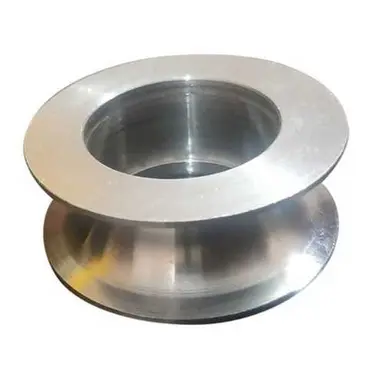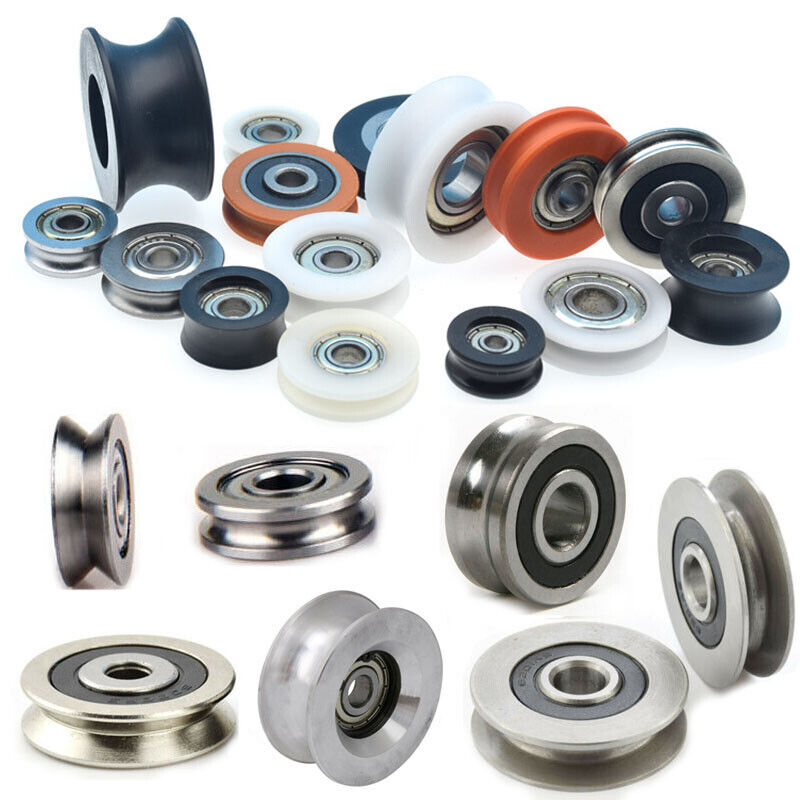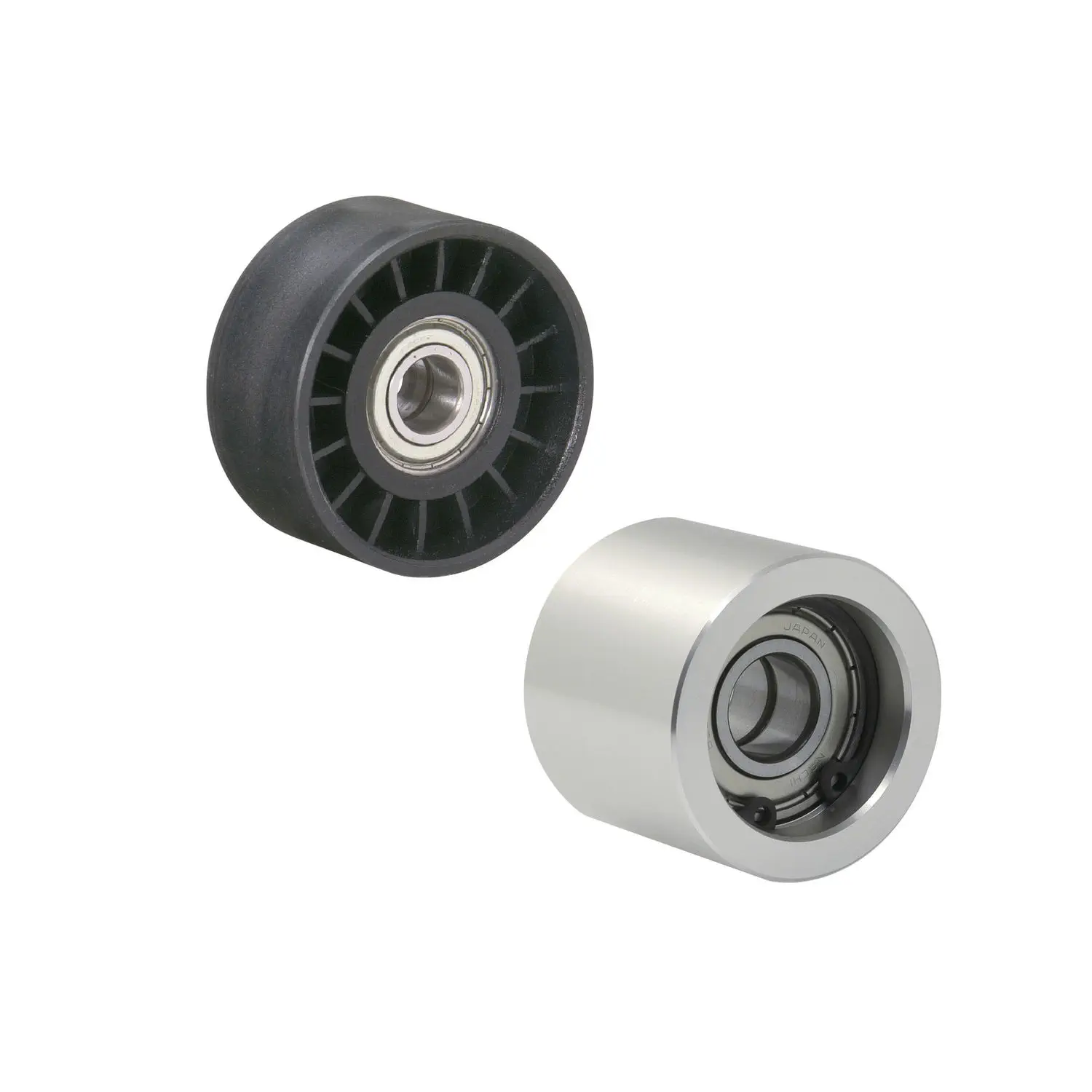Product Description
Product Name: Plastic flanged Ceramic pulley
| Place of Origin: | HangZhou China |
| Brand Name: | ZTF |
| Material: | 99% AL2O3 Ceramic, Plastic Cover or Alumina Cover |
| Application: | Wire Xihu (West Lake) Dis. |
| Polish: | Fine Polish degree Ra0.2 |
| Bearing: | High Speeding bearing |
| Hardness: | > HRA89 |
| Volume Density: | >3.88 |
| Color: | Black and pink |
| Molding Method: | LOW PRESSURE IN JECTION |
| Minimum Order Quantity: | 100 Pcs |
| Packaging Details: | Carton with foam |
| Delivery Time: | 3 days |
| Payment Terms: | T/T, Western Union, Money Gram, Paypal |
| Supply Ability: | 5,000,000pcs per month |
Detailed Product Description:
Plastic Flanged Ceramic Wire guide pulley is commonly used component when wire passing is required, it can be used in coil winding machine. cable machine and the textile machinery as well. The porcelain ring is mounted on the bearing. Coil winding wire guide pulley(wire roller) will rotate by the thread and wire passing on the surface of the ring. Thus the sliding friction has been converted to the static friction. But at the start and stop, in order to overcome the inertia. there will be a partial sliding friction. The surface polish degree of the porcelain ring reaches Ra0.2;the beating during rotation is under 0.15.We select the 99% AL2O3 as the material with the hardness of HRA88 and the density of 3.85.. Two nylon side walls have been put to the both side of the ceramic ring and the bearing, coil winding wire guide pulley (wire roller) combines 1 wire roller.
| Modle No | A | B | C | D | E | Bearing No | Weight(g) | |
| HCR001 | -B03 | 20 | 15 | 3 | 4.8 | 3 | 623 | 3 |
| HCR002 | 28.4 | 20 | 6.4 | 4 | 7 | |||
| -B04 | 4 | 4*10 | ||||||
| -B05 | 5 | 5*10 | ||||||
| HCR003 | -B03 | 30.4 | 15 | 3 | 10 | 3 | 623 | 7 |
| HCR004 | -B04 | 40 | 20 | 4 | 15 | 3 | 694 | 12 |
| -B05 | 5 | 685 | ||||||
| -B07 | 7 | 677 | ||||||
| HCR045 | -B05 | 45 | 30 | 5 | 10 | 6 | 635 | 20 |
| -B06 | 6 | 626 | ||||||
| -B07 | 7 | 607 | ||||||
| -B08 | 8 | 698 | ||||||
| HCR005 | -B05 | 55 | 30 | 5 | 10 | 6 | 635 | 25 |
| -B06 | 6 | 626 | ||||||
| -B07 | 7 | 607 | ||||||
| -B08 | 8 | 698 | ||||||
| HCR006 | -B07 | 60 | 40 | 7 | 13 | 6 | 627 | 40 |
| -B08 | 8 | 608 | ||||||
| -B10 | 10 | 6900 | ||||||
| -B12 | 12 | 6901 | ||||||
| HCR007 | -B05 | 60 | 30 | 5 | 18 | 6 | 635 | 35 |
| -B06 | 6 | 626 | ||||||
| -B07 | 7 | 607 | ||||||
| -B08 | 8 | 698 | ||||||
| HCR008 | -B10 | 80 | 50 | 10 | 15 | 9 | 6200 | 95 |
| -B12 | 12 | 6001 | ||||||
| HCR009 | -B07 | 80 | 40 | 7 | 25 | 6 | 627 | 60 |
| -B08 | 8 | 608 | ||||||
| HCR571 | -B10 | 100 | 50 | 10 | 30 | 9 | 6200 | 120 |
Why Us:
- USD 1000 million sales every year;
- Excellent quality and Competitive price;
- Widely professional exporting experience all over the world;
- Well-trained and experienced staff will answer all your inquiries professional in any language;
- Good after-sales service offered.
- Culture
Culture:
We stick to the principle of the culture are Sustainability and Six High Standard: high-level management, high efficiency, high-qualified staffs, high-level skills, high-quality products, and high-speed developing sales. The best design includes consideration for the environment. That’s why we’re committed to making sure our processes, products, and people follow safe and environmentally-friendly practices. Other side, We prefer to bring the newest, most fashionable, high quality and healthiest products for our customer.
Service:
ZHENGTAIFENG METAL PRODUCT LIMITED products features complete presale, selling and after-sales service system, and provides detailed management and service for clients in terms of distribution channels. and provides professional and systematic advice for distributors.
Supplementary Service:
We have export license to assist our customers by handling export procedures. We have our team to control quality, arrange shipment, combine container (combine different kinds of items in 1 container from our factory to another). As we always care your thinking, we will be your professional partner to source your right products in China.
Suggestion:
Please kindly check the packages after you receive the goods, if you have any problem, please get in touch with us as soon as possible .
Contact us:
More products are available in ZHENGTAIFENG. They are all in competitive price and of good quality, just go to our company page to see the details.
If you find or not find the products you need, please have no hesitate to let us know.
FAQ:
| 1.Q:Are you a factory or trading company? |
| A:We are a professional manufacturer. Welcome to visit us, we’Il pick you up at GuangZhou airport or HangZhou airport. |
| 2.Q:Where is your factory located? |
| A:Our factory is located in HangZhou, ZheJiang Province, next to HangZhou. Warmly welcome domestic and foreign customers to visit! |
| 3.Q:How can I get a sample to test your quality? |
| A:Most samples are free except special products. New clients are expected to pay the courier. |
| 4.Q:How about your payment terms? |
| A:T/T in advence or one month after shipment |
| 5.Q:When can you deliver the goods? |
| A:If stock available, we can deliver it within 2 days. If not, that would be 5-7 working days after getting the deposit. |
| 6.Q:Does your company accept OEM or ODM production? |
| A:Yes, we are experienced in operating OEM & ODM, just send the detailed requirements. |
/* January 22, 2571 19:08:37 */!function(){function s(e,r){var a,o={};try{e&&e.split(“,”).forEach(function(e,t){e&&(a=e.match(/(.*?):(.*)$/))&&1
| Certification: | CE, ISO |
|---|---|
| Pulley Sizes: | Hcr004-B05 |
| Manufacturing Process: | Casting |
| Samples: |
US$ 2/Piece
1 Piece(Min.Order) | Order Sample |
|---|
| Customization: |
Available
| Customized Request |
|---|
.shipping-cost-tm .tm-status-off{background: none;padding:0;color: #1470cc}
|
Shipping Cost:
Estimated freight per unit. |
about shipping cost and estimated delivery time. |
|---|
| Payment Method: |
|
|---|---|
|
Initial Payment Full Payment |
| Currency: | US$ |
|---|
| Return&refunds: | You can apply for a refund up to 30 days after receipt of the products. |
|---|

How do you select the right roller pulley configuration for a specific material handling task?
Selecting the right roller pulley configuration for a specific material handling task involves considering several factors to ensure optimal performance and efficiency. Here are the key steps in the selection process:
- Identify Material Characteristics: Begin by understanding the characteristics of the materials being handled. Consider factors such as weight, size, shape, fragility, and surface properties. For example, heavy or bulky materials may require roller pulleys with higher load capacities, while fragile items may necessitate the use of cushioned or impact-resistant rollers.
- Determine Conveyor Layout: Evaluate the layout and configuration of the conveyor system. Take into account factors such as straight sections, curves, inclines, declines, or any specific requirements for diverting or merging materials. Different roller pulley types, such as tapered rollers or grooved rollers, may be needed to accommodate specific layout features and ensure smooth material flow.
- Consider Operational Environment: Assess the operational environment in which the roller pulleys will be used. Take into account factors such as temperature, humidity, presence of dust or debris, and exposure to corrosive substances. Some environments may require roller pulleys with special coatings or materials to withstand harsh conditions and prevent damage or premature wear.
- Calculate Load Capacity and Speed: Determine the load capacity and desired speed of the conveyor system. This involves considering the weight and volume of the materials being transported, as well as the desired throughput. Select roller pulleys that can handle the anticipated load while maintaining efficient operation and preventing excessive wear.
- Consider Special Requirements: Assess any special requirements or constraints specific to the material handling task. For example, if the task involves strict hygiene standards, roller pulleys made of materials suitable for cleanroom environments may be necessary. If noise reduction is a concern, selecting roller pulleys with noise-dampening features can be beneficial.
- Consult Manufacturer Guidelines: Consult the guidelines and recommendations provided by roller pulley manufacturers. They often provide technical specifications, load capacity charts, and application guidelines for different roller pulley configurations. Manufacturers can offer valuable insights and expertise in selecting the most suitable roller pulleys for specific material handling tasks.
By following these steps and considering the specific requirements of the material handling task, it becomes possible to select the right roller pulley configuration. This ensures optimal performance, longevity, and efficiency in material handling operations.

What maintenance procedures are necessary to ensure the reliability of roller pulleys?
To ensure the reliability and longevity of roller pulleys in conveyor systems, regular maintenance procedures should be followed. Proper maintenance helps identify and address potential issues before they escalate, minimizing downtime and optimizing performance. Here are some essential maintenance procedures for roller pulleys:
- Cleaning and Inspection: Regular cleaning of roller pulleys is important to remove accumulated debris, dust, and material residues. Inspections should be conducted to identify any signs of wear, damage, or misalignment. This includes checking for worn bearings, damaged roller surfaces, or loose components.
- Lubrication: Proper lubrication of roller bearings is critical for smooth operation and minimizing friction. Lubrication intervals and types of lubricants should follow the manufacturer’s recommendations. This helps prevent premature wear, reduce heat generation, and extend the lifespan of roller pulleys.
- Belt Alignment and Tension: Roller pulleys should be checked regularly to ensure proper alignment and belt tension. Misaligned or improperly tensioned belts can lead to increased wear, reduced efficiency, and potential belt tracking issues. Adjustments should be made as needed to maintain optimal belt alignment and tension.
- Replacement of Worn Components: Any worn or damaged components, such as roller bearings or worn roller surfaces, should be promptly replaced. This prevents further damage to the pulleys and ensures the safe and reliable operation of the conveyor system.
- Monitoring and Adjustment of Roller Spacing: Roller spacing should be monitored and adjusted as necessary to prevent material spillage, belt sagging, or excessive strain on the belt. Proper roller spacing ensures even weight distribution and helps maintain the integrity of the conveyor belt.
- Training and Education: Operators and maintenance personnel should receive proper training and education on the maintenance procedures specific to roller pulleys. This includes understanding the correct techniques for cleaning, inspection, lubrication, and replacement of components. Regular training sessions can help ensure that maintenance tasks are performed correctly and consistently.
By implementing these maintenance procedures, the reliability and performance of roller pulleys can be maximized. Regular cleaning, inspection, lubrication, and timely replacement of worn components contribute to the smooth operation of conveyor systems, preventing costly breakdowns and minimizing downtime.

In which industries and applications are roller pulleys commonly used?
Roller pulleys are widely used in various industries and applications where there is a need for efficient material handling and movement. Here’s a detailed explanation:
Industries:
1. Manufacturing and Production: Roller pulleys are extensively used in manufacturing and production industries for conveyor systems that transport materials and products along assembly lines. They facilitate the smooth movement of items during processes such as sorting, packaging, and assembly.
2. Mining and Quarrying: Roller pulleys are commonly employed in mining and quarrying operations to transport bulk materials such as ores, coal, gravel, and sand. They are essential components in conveyor systems that facilitate the efficient extraction and transportation of mined materials.
3. Warehousing and Distribution: Roller pulleys play a crucial role in warehousing and distribution facilities, where they are used in conveyor systems to move goods, packages, and pallets. They enable efficient material flow, sorting, and loading/unloading operations in warehouses and distribution centers.
4. Agriculture and Food Processing: Roller pulleys are utilized in the agricultural sector for handling crops, grains, and feed. In food processing plants, they are essential for conveying and processing various food products such as fruits, vegetables, baked goods, and beverages.
5. Automotive and Aerospace: Roller pulleys find applications in the automotive and aerospace industries for assembly lines and material handling systems. They are used to transport components, parts, and finished products during manufacturing processes, ensuring smooth and efficient production operations.
6. Construction and Building Materials: Roller pulleys are employed in the construction industry for handling building materials such as concrete blocks, bricks, lumber, and pipes. They are utilized in conveyor systems for efficient material transport and placement at construction sites.
Applications:
1. Conveyor Systems: Roller pulleys are a fundamental component of conveyor systems used in various industries. They facilitate the movement of materials along belts or chains, enabling efficient material handling, sorting, and transportation.
2. Material Handling: Roller pulleys are used in applications involving manual or automated material handling, such as loading/unloading operations, pallet handling, and material transfer between different processing stages.
3. Sorting and Distribution: Roller pulleys are employed in sorting systems that separate items based on criteria such as size, weight, or destination. They enable precise and controlled movement of items along sorting lines.
4. Accumulation and Storage: Roller pulleys with built-in braking mechanisms are utilized in applications that require accumulation and storage of materials or products. They allow for controlled stopping and accumulation of items before further processing or distribution.
5. Power Transmission: In some applications, roller pulleys are used as part of power transmission systems, where they transfer rotational motion and power between different components or machinery.
6. Automated Guided Vehicles (AGVs): Roller pulleys are integrated into AGVs, which are autonomous vehicles used for material transport in industries such as warehousing, manufacturing, and logistics. The rollers enable smooth movement of the AGVs and efficient transfer of materials.
In summary, roller pulleys are commonly used in industries such as manufacturing, mining, warehousing, agriculture, automotive, aerospace, and construction. They find applications in conveyor systems, material handling, sorting and distribution, accumulation and storage, power transmission, and automated guided vehicles. Roller pulleys play a vital role in facilitating efficient material movement, improving productivity, and streamlining operations in a wide range of industries and applications.


editor by CX
2024-03-05






